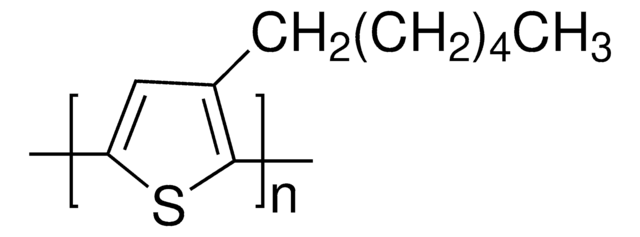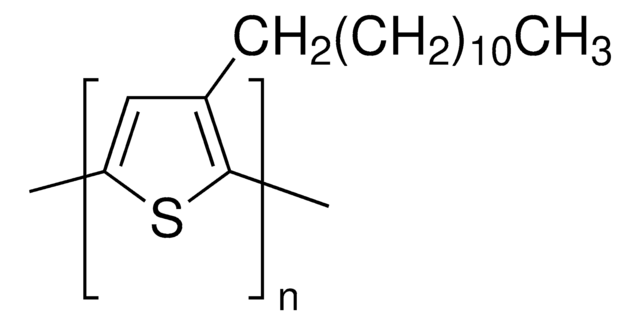682799
P3OT
regioregular, electronic grade, 99.995% trace metals basis, average Mn ~25,000
Sinônimo(s):
Poly(3-octylthiophene-2,5-diyl)
Selecione um tamanho
Selecione um tamanho
About This Item
Produtos recomendados
Materiais
black
grau
electronic grade
descrição
Band gap: 1.7 eV
Ensaio
99.995% trace metals basis
Formulário
solid
peso molecular
average Mn ~25,000
pf
198-211 °C
Energia orbital
HOMO -5.25 eV
LUMO -3.55 eV
Desempenho do dispositivo OPV
ITO/PEDOT:PSS/P3OT:PC61BM (1:2)/LiF/Al
- Short-circuit current density (Jsc): 5.55 mA/cm2
- Open-circuit voltage (Voc): 0.5 V
- Fill Factor (FF): 0.33
- Power Conversion Efficiency (PCE): 0.91 %
propriedades semicondutoras
P-type (mobility=10−4 - 10−1 cm2/V·s)
cadeia de caracteres SMILES
[s]1cc(cc1)CCCCCCCC
InChI
1S/C12H20S/c1-2-3-4-5-6-7-8-12-9-10-13-11-12/h9-11H,2-8H2,1H3
chave InChI
WQYWXQCOYRZFAV-UHFFFAOYSA-N
Categorias relacionadas
Descrição geral
Aplicação
Rechargeable battery electrodes, electrochromic devices, chemical and optical sensors, light-emitting diodes, microelectrical amplifiers, field-effect transistors and non-linear optical materials.
Used in organic field-effect transistors and in polymer-based solar cells.
Características e benefícios
Código de classe de armazenamento
11 - Combustible Solids
Classe de risco de água (WGK)
WGK 3
Ponto de fulgor (°F)
Not applicable
Ponto de fulgor (°C)
Not applicable
Equipamento de proteção individual
Eyeshields, Gloves, type N95 (US)
Escolha uma das versões mais recentes:
Certificados de análise (COA)
Não está vendo a versão correta?
Se precisar de uma versão específica, você pode procurar um certificado específico pelo número do lote ou da remessa.
Já possui este produto?
Encontre a documentação dos produtos que você adquiriu recentemente na biblioteca de documentos.
Os clientes também visualizaram
Artigos
The application of conducting polymers at the interface with biology is an exciting new trend in organic electronics research.
Organic materials in optoelectronic devices like LEDs and solar cells are of significant academic and commercial interest.
Novel Graphene‑Based Nanostructures Production, Functionalization, and Engineering
Intrinsically stretchable active layers for organic field-effect transistors (OFET) are discussed. Polymer structural modification & post-polymerization modifications are 2 methods to achieve this.
Active Filters
Nossa equipe de cientistas tem experiência em todas as áreas de pesquisa, incluindo Life Sciences, ciência de materiais, síntese química, cromatografia, química analítica e muitas outras.
Entre em contato com a assistência técnica









